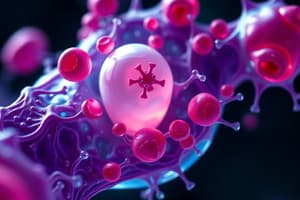Podcast
Questions and Answers
Which of the following functions is NOT associated with the smooth endoplasmic reticulum (SER)?
Which of the following functions is NOT associated with the smooth endoplasmic reticulum (SER)?
- Steroid hormone synthesis
- Detoxification
- Lipid metabolism
- Protein secretion (correct)
What unique characteristic do mitochondria possess?
What unique characteristic do mitochondria possess?
- Ability to synthesize their own DNA (correct)
- Irreversible self-destruction
- Complete independence from the cell
- Inability to change shape
Which of the following is true regarding lysosomes?
Which of the following is true regarding lysosomes?
- They synthesize proteins.
- They are involved in lipid metabolism.
- They contain hydrolytic enzymes. (correct)
- They have a pH of 7.
What is one of the key roles of rough endoplasmic reticulum (RER)?
What is one of the key roles of rough endoplasmic reticulum (RER)?
Which statement best describes the outer membrane of mitochondria?
Which statement best describes the outer membrane of mitochondria?
Which function is primarily carried out by peroxisomes?
Which function is primarily carried out by peroxisomes?
What is a characteristic of the rough endoplasmic reticulum?
What is a characteristic of the rough endoplasmic reticulum?
What is the primary function of ribosomes in a eukaryotic cell?
What is the primary function of ribosomes in a eukaryotic cell?
Which cell organelle is responsible for modifying and packaging secretory products?
Which cell organelle is responsible for modifying and packaging secretory products?
What is included in the structure of ribosomes to stabilize their formation?
What is included in the structure of ribosomes to stabilize their formation?
Which component of a eukaryotic cell is primarily responsible for energy production?
Which component of a eukaryotic cell is primarily responsible for energy production?
Which organelle is involved in the synthesis of polysaccharides?
Which organelle is involved in the synthesis of polysaccharides?
Which organelle is directly responsible for synthesizing ribosomal RNA?
Which organelle is directly responsible for synthesizing ribosomal RNA?
What structure in the eukaryotic cell serves as the selective barrier regulating entry and exit of substances?
What structure in the eukaryotic cell serves as the selective barrier regulating entry and exit of substances?
Which of the following components is NOT found within a eukaryotic cell?
Which of the following components is NOT found within a eukaryotic cell?
Flashcards are hidden until you start studying
Study Notes
Cell Structure and Function
- Cell Structure: Composed of various organelles, including the nucleus, ribosomes, endoplasmic reticulum, Golgi apparatus, centriole, mitochondria, and vesicles.
- Nucleus: Contains genetic material (DNA) and directs cellular processes.
- Ribosomes: Responsible for protein synthesis, composed of a large (60S) and small (40S) subunit containing rRNA.
- Endoplasmic Reticulum (ER): Network of interconnected membranes involved in synthesis, packaging, and processing of molecules.
- Rough ER (RER): Rich in ribosomes, involved in protein synthesis for secretion, integral membrane proteins, and lysosomal enzymes.
- Core Glycosylation: Modification of proteins by adding sugar molecules to the protein structure.
- Smooth ER (SER): Involved in lipid metabolism, steroid hormone synthesis, gluconeogenesis, detoxification, and calcium storage.
- Rough ER (RER): Rich in ribosomes, involved in protein synthesis for secretion, integral membrane proteins, and lysosomal enzymes.
- Golgi Apparatus: Modifies, sorts, packages, and concentrates secretory products.
- Vesicles: Small membrane-bound sacs that transport materials within and outside the cell.
- Granules: Contain secretory products.
- Lysosomes: Degrade material with hydrolytic enzymes, maintain a pH of 5.
- Peroxysomes: Involved in hydrogen peroxide metabolism and oxidation of fatty acids.
- Mitochondria: The powerhouse of the cell, responsible for energy production (ATP) through cellular respiration.
- mtDNA: Contains its own DNA, inherited maternally.
- Structure: Contains two membranes, an outer permeable membrane and an inner selectively permeable membrane.
- Function: Synthesizes its own proteins, can move and change shape.
Eukaryotic Cell
- Characteristic of animal cells, plant cells, fungi, and protists.
- Possesses a nucleus, ribosomes, ER, Golgi, mitochondria, and other organelles.
- Complex and organized structure.
The Cell
- Cells come in various shapes and forms, adapted to their specific functions.
- Diverse structures optimized for specific roles in the body.
#celltember
- A popular hashtag often used on social media to share information about cell biology during September.
- Increases awareness about cell biology and promotes research.
Studying That Suits You
Use AI to generate personalized quizzes and flashcards to suit your learning preferences.




